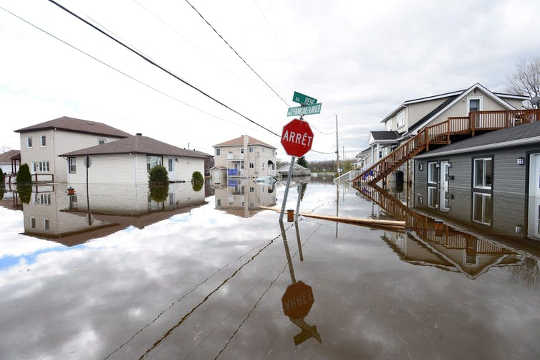
The lack of political will to meet emission targets could see more extreme flooding in the future, like what happened the Québec community of Gatineau in 2017. THE CANADIAN PRESS/Sean Kilpatrick
It seems like a day doesn’t pass without the release of yet another study that shows human actions will inevitably increase the Earth’s average temperature past a tipping point that will lead to runaway climate change.
This increase is occurring despite the many climate policy promises from governments around the world. Canada, like most countries, has ambitious climate targets: an 80 per cent reduction in greenhouse gas (GHG) emissions by 2050.
A new study called the Canadian Energy Outlook - 2050, prepared by Polytechnique Montréal and Pôle e3 at the HEC Montréal business school, suggests current reduction efforts are inadequate to meet these promises. Yet, the study also suggests the targets are far from being out of reach — thanks in part to the rapid decline in the cost of transforming our energy sector to low carbon emission technologies.
Targets won’t be met
The study, based on technical and economic models prepared by the Montréal firm ESMIA, explored five scenarios for the energy system in Canada and each province until 2050. Its conclusion: neither the federal government nor any of the provinces, with the exception of Nova Scotia, has put in place measures that will allow them to meet their respective 2030 or 2050 targets.
While Canada has committed to a 30 per cent reduction in GHG emissions by 2030 compared to 2005, the study’s modelling suggests that, even including any existing and announced federal and provincial measures, current emissions will remain constant and even increase by 10 per cent by 2050.
This means the federal government’s own estimates, which predict Canada would still achieve a reduction of about 10 per cent in GHG emissions by 2030, are overly optimistic.
 A young woman chains herself to a fence during a 2016 protest in Québec over the Trans-Northern pipeline project. THE CANADIAN PRESS/Ryan Remiorz
A young woman chains herself to a fence during a 2016 protest in Québec over the Trans-Northern pipeline project. THE CANADIAN PRESS/Ryan Remiorz
One of the key findings of this study is a detailed province-by-province analysis of four reduction scenarios that assess the energy trajectories that need to be followed to achieve: (1) provincial targets; (2) federal targets (30 per cent reduction compared to 2005 by 2030 and 80 per cent by 2050); (3) international targets (80 per cent compared to 1990 by 2050) and (4) federal targets with the purchase of 20 per cent of GHG emission allowances from California, according to Canada’s National Report to the United Nations Framework Convention on Climate Change in late 2017.
Objectives are possible
The most significant findings of these models is that the most ambitious objectives to reduce GHG emissions are both technically and economically possible.
Indeed, the marginal cost of the last equivalent tonne of CO2 eliminated in 2050 to meet international targets is estimated at about $1,000. While this cost may seem high compared to the carbon price today (about $20 per tonne under the federal program), it is comparable to the cost of reducing emissions from programs run by the Green Fund in Québec.
More importantly, this amount is 30 per cent lower than a similar assessment made only three years ago for a scenario of a 70 per cent reduction in GHG emissions. That assessment projected a marginal cost of $1,400 per tonne of CO2 equivalent. The difference is mainly due to the speed of technological changes in the energy sector and the fall in the prices of solar energy and batteries.
The analysis of the impact of these objectives on the provinces also reveals unexpected trends. For instance, although Saskatchewan now opposes a carbon price, by 2050 the province would not have to pay more than the rest of Canada to meet the national targets. Models show that Saskatchewan could even reduce its emissions by 90 per cent by 2050, while Canada as a whole could reduce them by 80 per cent.
Problems in Ontario
In contrast, Ontario appears to have more difficulty transforming its energy system. At Canada’s marginal cost, the province would reduce its emissions by only 70 per cent, suggesting the importance of supporting the development of new green technologies.
 The oil sands of Fort McMurray, Alta. THE CANADIAN PRESS/Jason Franson
The oil sands of Fort McMurray, Alta. THE CANADIAN PRESS/Jason Franson
To optimize GHG reduction, each province will need to adopt unique solutions that reflect its resources and environment. It’s also essential for all levels of government — from municipal to provincial to federal to provincial — to adopt a collaborative approach based on science and best practices.
This approach should make it possible to develop integrated strategies, both in the production of energy and in its use.
If the climate objectives for 2030 and 2050 are going to be economically realistic, as shown in this Energy Outlook, the transformation that will be needed is profound. And it won’t succeed without the support of a true transition strategy — which is unfortunately still sorely lacking at all levels of government in Canada.![]()
About The Author
Normand Mousseau, Directeur de l’Institut de l’énergie Trottier, Polytechnique Montréal et Professeur de physique, Université de Montréal
This article is republished from The Conversation under a Creative Commons license. Read the original article.
Related Books
at InnerSelf Market and Amazon






















